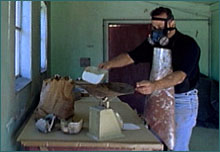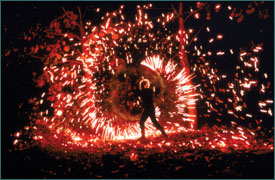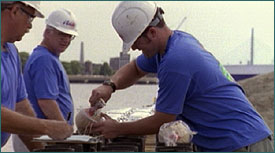
|

|
|
|
 With danger in the air, pyrotechnicians are
extremely cautious while assembling fireworks.
With danger in the air, pyrotechnicians are
extremely cautious while assembling fireworks.
|
Pyrotechnically Speaking
Part 2 |
Back to Part 1
NOVA: What are your greatest concerns in terms of
firework safety?
Conkling: Well, safety begins with manufacturing.
Manufacturers are very cautious to avoid any type of
ignition source when they're mixing powder together, when
they're assembling fireworks. They have large amounts of
powder, so there is always a potential for a serious
accident to occur. Training and good safety practices are
important.
When using fireworks at the consumer level, one should
follow the label directions very carefully and have a sober
adult in charge. At the big public displays, the biggest
concern for the public is giving the professionals room. The
safety zones they set up are there for a reason. Stay back a
safe distance and enjoy the show.
NOVA: Today, there are some states where you can't
buy fireworks but you can buy firearms. Should fireworks be
legal in every state?
Conkling: We now have very strict federal regulations
for consumer fireworks. All 50 states currently allow the
licensed public display to take place. There are now, I
believe, 41 states that do permit the public to use
something, ranging from the wire sparklers in novelties up
to a reasonable assortment of consumer fireworks. All those
have to meet federal safety standards of the Consumer
Product Safety Commission. I believe that devices that meet
those federal standards, used in an appropriate place by a
reasonably competent person—again, the sober adult
comes into play—can be used safely and enjoyably. It's
not necessary to prohibit them.
 Two words should define the user of consumer
fireworks, says Conkling: "sober adult."
Two words should define the user of consumer
fireworks, says Conkling: "sober adult."
|
|
It's important to allow devices appropriate for the area,
however. In a populated area, you may not want the aerial
rockets, for example. But fountains that stay on the ground
and spray sparks can certainly be used very safely in those
areas.
NOVA: You now serve on an international fireworks
body, right?
Conkling: Yes. There's currently an effort to
harmonize the international standards for fireworks, both
their classification and performance, and I've been asked to
participate. We've been working to try to make it much
easier to exchange fireworks between countries, so
everybody's working with the same set of requirements.
NOVA: How did you first become interested in
fireworks?
Conkling: As a youngster I was fascinated by them,
but it was more through the chemistry. When I started my
college teaching, I began doing research with pyrotechnic
materials and found it to be an absolutely fascinating area
of chemistry, with a lot of questions that were not fully
answered at the time. It's a beautiful field to do
experiments in. When you get your red flame or blue flame,
it's very positive feedback that makes a lot of other areas
in chemistry pale in comparison.
|
 "If it's a nice, deep, vivid blue," says Conkling,
"I sort of take my hat off and say, 'Well, those
people knew what they were doing.'"
"If it's a nice, deep, vivid blue," says Conkling,
"I sort of take my hat off and say, 'Well, those
people knew what they were doing.'"
|
NOVA: Have you invented fireworks yourself?
Conkling: I've developed various compositions in both
the fireworks field and other areas of pyrotechnics,
including military applications and other civilian areas,
such as emergency signals, particularly delay compositions
or time-delays.
NOVA: What's your favorite kind of firework?
Conkling: I love a really good blue shell. To a
chemist, the blue color is the hardest to achieve. When I go
to a fireworks show, I always keep an eye out for the
quality of their blue. If it's a nice, deep, vivid blue, I
sort of take my hat off and say, "Well, those people knew
what they were doing."
NOVA: What's the most dazzling display you've ever
seen?
Conkling: When the American Pyrotechnics Association
had its 50th anniversary in 1998 at Disney World
in Florida, the "best of the best" in the industry put on a
salute that was fired from multiple sites. It was absolutely
spectacular. I give that the highest rating of any show I've
ever seen.
 Firework shells typically run up to about 12 inches
in diameter, but shells over three times as big have
had their day in the sun.
Firework shells typically run up to about 12 inches
in diameter, but shells over three times as big have
had their day in the sun.
|
|
NOVA: And what's the largest firework anyone has ever
set off?
Conkling: In practice, shells tend to run up to about
12 inches in diameter. The U.S. uses a few every year that
are 24 inches in diameter, and 36-inch shells have been
made. The biggest that people have tried to make were in the
40-inch-plus range.
In the mid-1970s the author George Plimpton launched an
effort get monster shells called Fat Man I and Fat Man II to
explode. The first one went off at ground level and was
deemed a failure. The other got up a few hundred feet and
burst, and was apparently quite spectacular. But I'd say 24
is about as big as anyone can go and have any hope of a
successful shell.
NOVA: How big across is the resulting burst of a
24-inch shell?
Conkling: Probably 1,000 feet. There's a tremendous
spread to the "stars" [the cube- or pellet-shaped chemical
constituents of fireworks—see
Anatomy of a Firework].
NOVA: Different cultures have different styles of
fireworks displays, is that right?
Conkling: Yes. Many of the European countries love
noise. There, colors are for the women and the kids, but the
real fireworks effect is the concussion. In the United
States, I think we're much more into beautiful color
displays.
The Japanese are into symmetry. They judge the quality of a
firework by the perfect symmetry of the burst. There cannot
be the slightest imperfection in the symmetrical pattern.
They have international competitions in which companies
compete, and it's a matter of great pride to be judged the
top fireworks manufacturer.
|
 Pyrotechnicians in American display shows typically
prefer a cosmopolitan range of firework varieties.
Pyrotechnicians in American display shows typically
prefer a cosmopolitan range of firework varieties.
|
NOVA: Do these different styles drive the type of
manufacturers that are working in different countries?
Conkling: Yes. Now, since the U.S. has traditionally
been the melting pot of the world, we tend to take the
technologies from all of these countries. A fireworks
display today is really an international event. You'll see
Chinese fireworks, Japanese fireworks, maybe some Australian
fireworks, Brazilian fireworks, French fireworks, and
Spanish fireworks as well as U.S.-manufactured product. We
do much more internationalization in our fireworks shows
today than most other countries.
NOVA: I've heard Japan does daytime displays. How
does that work?
Conkling: Many of the daytime fireworks are smoke
effects. When the firework bursts, a smoke cloud is
produced. You can create various colors and visual patterns
through the use of the smoke rather than through a burning
light effect.
NOVA: In closing, why do you think people love
fireworks so much?
Conkling: Well, obviously people like the glorious
entertainment—the bright lights and vivid colors and
loud noises. But there is something in the human spirit that
is somewhat in awe when these fireworks explode, something
that gets to some of our basic instincts. It's more than the
pretty colors or pretty lights. It goes right back to man's
fascination with fire.
Interview conducted by Peter Tyson, editor in chief of
NOVA Online
Photo credits
Name That Shell
|
Anatomy of a Firework
|
Pyrotechnically Speaking
|
On Fire
Resources
|
Transcript
|
Teacher's Guide
|
Site Map
|
Fireworks! Home
Search |
Site Map
|
Previously Featured
|
Schedule
|
Feedback |
Teachers |
Shop
Join Us/E-Mail
| About NOVA |
Editor's Picks
|
Watch NOVAs online
|
To print
PBS Online |
NOVA Online |
WGBH
©
| Updated January 2002
|
|
|
|